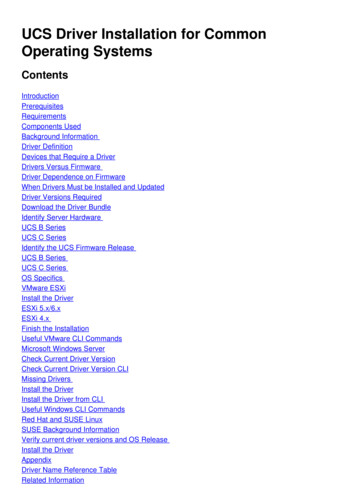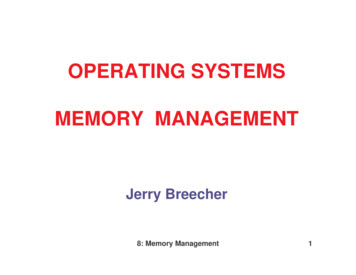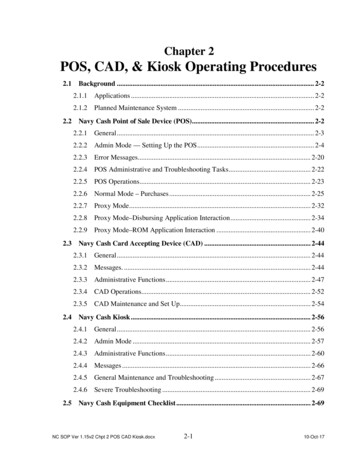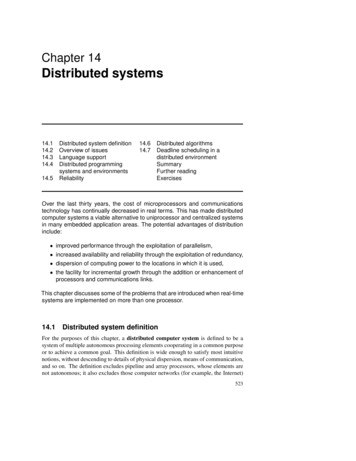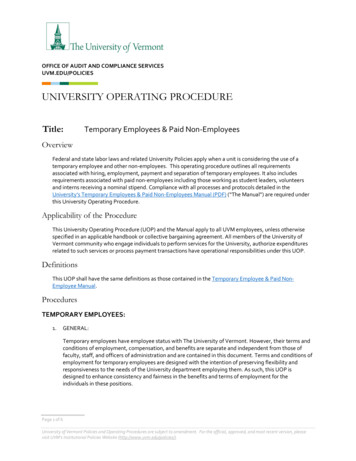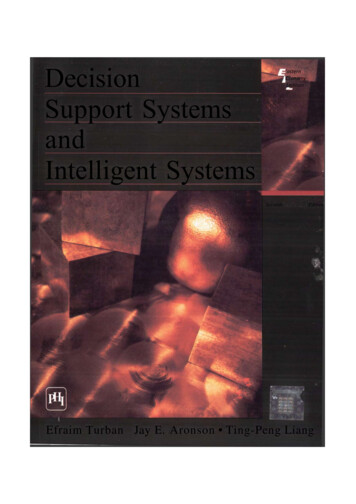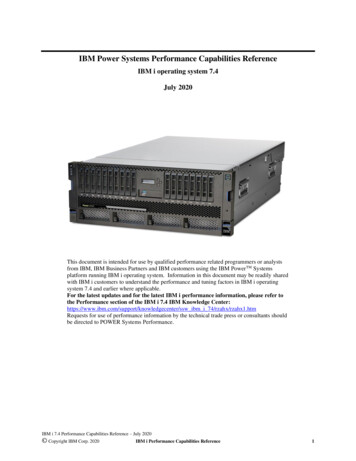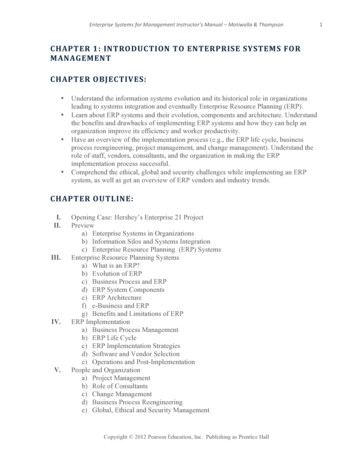
Transcription
Chapter 4: Operating SystemsOutline Functional Aspects! Data Types!Scheduling!Stacks!System Calls!Handling Interrupts!Multithreading!Thread-based vs. Event-based Programming!Memory Allocation!Non-Functional Aspects! Separation of Concern!System Overhead!Portability!Dynamic Reprogramming!Prototypes! TinyOS!SOS!Contiki!LiteOS!Evaluation!Fundamentals of Wireless Sensor Networks: Theory and PracticeWaltenegus Dargie and Christian Poellabauer 2010 John Wiley & Sons Ltd.2!Operating Systems An operating System is! a thin software layer! resides between the hardware and the application layer! provides basic programming abstractions to applicationdevelopers! Its main task is to enable applications to interact withhardware resources!Fundamentals of Wireless Sensor Networks: Theory and PracticeWaltenegus Dargie and Christian Poellabauer 2010 John Wiley & Sons Ltd.3!
Operating Systems Operating systems are classified as: single-task/multitasking and single-user/multiuser operating systems! multi-tasking OS - the overhead of concurrent processingbecause of the limited resources! single task OS - tasks should have a short duration! The choice of a particular OS depends on severalfactors; typically functional and non-functional aspects!Fundamentals of Wireless Sensor Networks: Theory and PracticeWaltenegus Dargie and Christian Poellabauer 2010 John Wiley & Sons Ltd.4!Outline Functional Aspects! Data Types!Scheduling!Stacks!System Calls!Handling Interrupts!Multithreading!Thread-based vs. Event-based Programming!Memory Allocation!Non-Functional Aspects! Separation of Concern!System Overhead!Portability!Dynamic Reprogramming!Prototypes! TinyOS!SOS!Contiki!LiteOS!Evaluation!Fundamentals of Wireless Sensor Networks: Theory and PracticeWaltenegus Dargie and Christian Poellabauer 2010 John Wiley & Sons Ltd.5!Data Types Interactions between the different subsystems take placethrough:! well-formulated protocols! data types! Complex data types have strong expression power butconsume resources - struct and enum! Simple data types are resource efficient but have limitedexpression capability - C programming language!Fundamentals of Wireless Sensor Networks: Theory and PracticeWaltenegus Dargie and Christian Poellabauer 2010 John Wiley & Sons Ltd.6!
Scheduling Two scheduling mechanisms: ! queuing-based scheduling ! FIFO - the simplest and has minimum system overhead, but treatstasks unfairly! sorted queue - e.g., shortest job first (SJF) - incurs system overhead(to estimate execution duration)! round-robin scheduling! a time sharing scheduling technique! several tasks can be processed concurrently!Fundamentals of Wireless Sensor Networks: Theory and PracticeWaltenegus Dargie and Christian Poellabauer 2010 John Wiley & Sons Ltd.7!Scheduling Regardless of how tasks are executed, a scheduler canbe either! a non-preemptive scheduler - a task is executed to the end, maynot be interrupted by another task! or preemptive scheduler - a task of higher priority may interrupta task of low priorityFundamentals of Wireless Sensor Networks: Theory and PracticeWaltenegus Dargie and Christian Poellabauer 2010 John Wiley & Sons Ltd.8!Stacks & System Calls Stacks! a data structure that temporarily stores data objects in memoryby piling one upon another! objects are accessed using last-in-first-out (LIFO)! System Calls! decouple the concern of accessing hardware resources fromimplementation details! whenever users wish to access a hardware resource, theyinvoke these operations without the need to concern themselveshow the hardware is accessed!Fundamentals of Wireless Sensor Networks: Theory and PracticeWaltenegus Dargie and Christian Poellabauer 2010 John Wiley & Sons Ltd.9!
Handling Interrupts An interrupt is an asynchronous signal generated by ! a hardware device! several system events! OS itself! An interrupt causes:! the processor to interrupt executing the present instruction! to call for an appropriate interrupt handler! Interrupt signals can have different priority levels, a highpriority interrupt can interrupt a low level interrupt! Interrupt mask: let programs choose whether or not theywish to be interruptedFundamentals of Wireless Sensor Networks: Theory and PracticeWaltenegus Dargie and Christian Poellabauer 2010 John Wiley & Sons Ltd.10!Multi-threading A thread is the path taken by a processor or a programduring its execution! Multi-threading - a task is divided into several logicalpieces! scheduled independent from each other! executed concurrently! Two advantages of a multi-threaded OS:!1. tasks do not block other tasks!2. short-duration tasks can be executed along with long-durationtasksFundamentals of Wireless Sensor Networks: Theory and PracticeWaltenegus Dargie and Christian Poellabauer 2010 John Wiley & Sons Ltd.11!Multi-threading Threads cannot be created endlessly ! the creation of threads slows down the processor! no sufficient resources to divide! The OS can keep the number of threads to amanageable size using a thread pool!Fundamentals of Wireless Sensor Networks: Theory and PracticeWaltenegus Dargie and Christian Poellabauer 2010 John Wiley & Sons Ltd.12!
Thread-based vs. Event-based Programming Decision whether to use threads or events programming:! need for separate stacks! need to estimate maximum size for saving context information! Thread-based programs use multiple threads of controlwithin:! a single program ! a single address space!Fundamentals of Wireless Sensor Networks: Theory and PracticeWaltenegus Dargie and Christian Poellabauer 2010 John Wiley & Sons Ltd.13!Thread-based vs. Event-based Programming Advantage:! a thread blocked can be suspended while other tasks areexecuted in different threads! Disadvantages:! must carefully protect shared data structures with locks! use condition variables to coordinate the execution of threadsFundamentals of Wireless Sensor Networks: Theory and PracticeWaltenegus Dargie and Christian Poellabauer 2010 John Wiley & Sons Ltd.14!Thread-based vs. Event-based Programming In event-based programming: use events and eventhandlers! event-handlers register with the OS scheduler to be notifiedwhen a named event occurs! a loop function: ! polls for events! calls the appropriate event-handlers when events occur! An event is processed to completion! unless its handler reaches at a blocking operation (callback andreturns control to the scheduler)!Fundamentals of Wireless Sensor Networks: Theory and PracticeWaltenegus Dargie and Christian Poellabauer 2010 John Wiley & Sons Ltd.15!
Memory Allocation The memory unit is a precious resource! Reading and writing to memory is costly ! How and for how long a memory is allocated for a piece of programdetermines the speed of task execution!Fundamentals of Wireless Sensor Networks: Theory and PracticeWaltenegus Dargie and Christian Poellabauer 2010 John Wiley & Sons Ltd.16!Memory Allocation Memory can be allocated to a program:! statically - a frugal approach, but the requirement of memorymust be known in advance! memory is used efficiently! runtime adaptation is not allowed! dynamically - the requirement of memory is not known inadvance (on a transient basis)! enables flexibility in programming! but produces a considerable management overhead!Fundamentals of Wireless Sensor Networks: Theory and PracticeWaltenegus Dargie and Christian Poellabauer 2010 John Wiley & Sons Ltd.17!Outline Functional Aspects! Data Types!Scheduling!Stacks!System Calls!Handling Interrupts!Multithreading!Thread-based vs. Event-based Programming!Memory Allocation!Non-Functional Aspects! Separation of Concern!System Overhead!Portability!Dynamic Reprogramming!Prototypes! TinyOS!SOS!Contiki!LiteOS!Evaluation!Fundamentals of Wireless Sensor Networks: Theory and PracticeWaltenegus Dargie and Christian Poellabauer 2010 John Wiley & Sons Ltd.18!
Separation of Concern In general, separation between the operating system andthe applications layer! The operation systems can provide:! a number of lightweight modules - “wired” together, or! an indivisible system kernel a set of library components forbuilding an application, or! a kernel a set of reconfigurable low-level services! Separation of concern enables:! flexible and efficient reprogramming and reconfiguration!Fundamentals of Wireless Sensor Networks: Theory and PracticeWaltenegus Dargie and Christian Poellabauer 2010 John Wiley & Sons Ltd.19!Portability Ideally, operating systems should be able to co-exist andcollaborate with each other! However, existing operating systems do not provide thistype of support! In order to accommodate unforeseen requirements,operating systems should be portable and extensibleFundamentals of Wireless Sensor Networks: Theory and PracticeWaltenegus Dargie and Christian Poellabauer 2010 John Wiley & Sons Ltd.20!System Overhead An operating system executes program code - requiresits own share of resources! The resources consumed by the OS are the systemʼsoverhead, it depends on! the size of the operating system ! the type of services that the OS provides to the higher-levelservices and applications!Fundamentals of Wireless Sensor Networks: Theory and PracticeWaltenegus Dargie and Christian Poellabauer 2010 John Wiley & Sons Ltd.21!
System Overhead The resources of wireless sensor nodes have to beshared by programs that carry out:! sensing! data aggregation! self-organization! network management! network communicationFundamentals of Wireless Sensor Networks: Theory and PracticeWaltenegus Dargie and Christian Poellabauer 2010 John Wiley & Sons Ltd.22!Dynamic Reprogramming Once a wireless sensor network is deployed, it may benecessary to reprogram some part of the application orthe operating system for the following reasons:!1. the network may not perform optimally!2. both the application requirements and the networkʼs operatingenvironment can change over time!3. may be necessary to detect and fix bugsFundamentals of Wireless Sensor Networks: Theory and PracticeWaltenegus Dargie and Christian Poellabauer 2010 John Wiley & Sons Ltd.23!Dynamic Reprogramming Manual replacement may not be feasible - develop anoperating system to provide dynamic reprogrammingsupport, which depends on! clear separation between the application and the OS! the OS can receive software updates and assemble and store it inmemory! OS should make sure that this is indeed an updated version! OS can remove the piece of software that should be updated and installand configure the new version! all these consume resources and may cause their own bugs!Fundamentals of Wireless Sensor Networks: Theory and PracticeWaltenegus Dargie and Christian Poellabauer 2010 John Wiley & Sons Ltd.24!
Dynamic Reprogramming Software reprogramming (update) requires robust codedissemination protocols:! splitting and compressing the code! ensuring code consistency and version controlling! providing a robust dissemination strategy to deliver the codeover a wireless linkFundamentals of Wireless Sensor Networks: Theory and PracticeWaltenegus Dargie and Christian Poellabauer 2010 John Wiley & Sons Ltd.25!Outline Functional Aspects! Data Types!Scheduling!Stacks!System Calls!Handling Interrupts!Multithreading!Thread-based vs. Event-based Programming!Memory Allocation!Non-Functional Aspects! Separation of Concern!System Overhead!Portability!Dynamic Reprogramming!Prototypes! TinyOS!SOS!Contiki!LiteOS!Evaluation!Fundamentals of Wireless Sensor Networks: Theory and PracticeWaltenegus Dargie and Christian Poellabauer 2010 John Wiley & Sons Ltd.26!TinyOS (Gay et al. 2007) TinyOS is the most widely used, richly documented, andtool-assisted runtime environment in WSN! static memory allocation ! event-based system! TinyOSʼs architecture consists of! a scheduler ! a set of components, which are classified into! configuration components - "wiring" (how models are connectedwith each other) ! modules - the basic building blocks of a TinyOS program!Fundamentals of Wireless Sensor Networks: Theory and PracticeWaltenegus Dargie and Christian Poellabauer 2010 John Wiley & Sons Ltd.27!
TinyOS (Gay et al. 2007) A component is made up of ! a frame! command handlers ! event handlers! a set of non-preemptive tasks! A component is similar to an object in object-basedprogramming languages:! it encapsulates state and interacts through well-definedinterfaces! an interface that can define commands, event handlers, andtasksFundamentals of Wireless Sensor Networks: Theory and PracticeWaltenegus Dargie and Christian Poellabauer 2010 John Wiley & Sons Ltd.28!TinyOS (Gay et al. 2007)Figure 4.1 Logical distinction between low-level and high-level components (Hill et al. 2000)Fundamentals of Wireless Sensor Networks: Theory and PracticeWaltenegus Dargie and Christian Poellabauer 2010 John Wiley & Sons Ltd.29!TinyOS (Gay et al. 2007) Components are structured hierarchically andcommunicate with each other through commands andevents:! higher-level components issue commands to lower-levelcomponents! lower-level components signal events to higher-levelcomponents! In Figure 4.1, two components at the highest levelcommunicate asynchronously through active messages! routing component - establishing and maintaining the network! sensor application - responsible for sensing and processingFundamentals of Wireless Sensor Networks: Theory and PracticeWaltenegus Dargie and Christian Poellabauer 2010 John Wiley & Sons Ltd.30!
TinyOS (Gay et al. 2007) The logical structure of components and componentconfigurationsFigure 4.3!Figure 4.4!A TinyOS components that uses an interface!A TinyOS configuration that wires an interfaceprovider and an interface user!In Figure 4.3, Component Bexpresses interest ininterface C by declaring acall to command D1 andby providing an eventhandler to process eventD2.!In Figure 4.4, a bindingbetween Component Aand Component B isestablished through theConfiguration E.Figure 4.2!A TinyOS component providing an interfaceIn Figure 4.2, Component Adeclares its service byproviding interface C,which in turn providescommand D1 and signalsevent D2.Fundamentals of Wireless Sensor Networks: Theory and PracticeWaltenegus Dargie and Christian Poellabauer 2010 John Wiley & Sons Ltd.31!Tasks, Commands and Events The fundamental building blocks of a TinyOS runtimeenvironment: tasks, commands, and events! enabling effective communication between the components of asingle frame! Tasks :! monolithic processes - should execute to completion - theycannot be preempted by other tasks, though they can beinterrupted by events! possible to allocate a single stack to store context information! call lower level commands; signal higher level events; and post(schedule) other tasks! scheduled based on FIFO principle (in TinyOS)Fundamentals of Wireless Sensor Networks: Theory and PracticeWaltenegus Dargie and Christian Poellabauer 2010 John Wiley & Sons Ltd.32!Tasks, Commands and Events Commands:! non-blocking requests made by higher-level components tolower-level components! split-phase operation: ! a function call returns immediately! the called function notifies the caller when the task is completed! Events: ! events are processed by the event handler! event handlers are called when hardware events occur! an event handler may react to the occurrence of an event indifferent ways! deposit information into its frame, post tasks, signal higher levelevents, or call lower level commandsFundamentals of Wireless Sensor Networks: Theory and PracticeWaltenegus Dargie and Christian Poellabauer 2010 John Wiley & Sons Ltd.33!
Outline Functional Aspects! Data Types!Scheduling!Stacks!System Calls!Handling Interrupts!Multithreading!Thread-based vs. Event-based Programming!Memory Allocation!Non-Functional Aspects! Separation of Concern!System Overhead!Portability!Dynamic Reprogramming!Prototypes! TinyOS!SOS!Contiki!LiteOS!Evaluation!Fundamentals of Wireless Sensor Networks: Theory and PracticeWaltenegus Dargie and Christian Poellabauer 2010 John Wiley & Sons Ltd.34!SOS (Han et al. 2005) The SOS operating system (Han et al. 2005)! establishes a balance between flexibility and resource efficiency! supports runtime reconfiguration and reprogramming! The SOS operating system consists of:! a kernel :! provides interfaces to the underlying hardware! provides priority-based scheduling mechanism! supports dynamic memory allocation! a set of modules – can be loaded and unloaded - a positionindependent binary! enables SOS to dynamically link modules with each other!Fundamentals of Wireless Sensor Networks: Theory and PracticeWaltenegus Dargie and Christian Poellabauer 2010 John Wiley & Sons Ltd.35!Interaction Interaction with a module through:!1. messages (asynchronous communication)! a message that originates from module A to module B! the message goes through the scheduler! the kernel calls the appropriate message handler in module B and passes themessage to it!2. direct calls to registered functions (synchronous communication)! requires modules to register their public functions at the kernel - allmodules can subscribe to these functions ! the kernel creates a function control block (FCB) to store key information aboutthe function!this information is used to:! handle function subscription! support dynamic memory management! support runtime module update (replacement)Fundamentals of Wireless Sensor Networks: Theory and PracticeWaltenegus Dargie and Christian Poellabauer 2010 John Wiley & Sons Ltd.36!
InteractionFigure 4.5 illustrates the two basic types of interactions between modules Interaction through a function call is faster than message-based communicationFundamentals of Wireless Sensor Networks: Theory and PracticeWaltenegus Dargie and Christian Poellabauer 2010 John Wiley & Sons Ltd.37!Dynamic Reprogramming Five basic features enable SOS to support dynamicreprogramming! modules are position independent binaries! they use relative addresses rather than absolute addresses ---they are re-locatable! every SOS module implements two types of handlers – the initand final message handlers! the init message handler - to set the moduleʼs initial state! the final message handler - to release all resources the moduleowns and to enable the module to exit the system gracefully! after the final message, the kernel performs garbage collection!Fundamentals of Wireless Sensor Networks: Theory and PracticeWaltenegus Dargie and Christian Poellabauer 2010 John Wiley & Sons Ltd.38!Dynamic Reprogramming SOS uses a linker script to place the init handler of a module at aknown offset in the binary! enables easy linking during module insertion! SOS keeps the state of a module outside of it! enables the newly inserted module to inherit the state information of themodule it replaces! Whenever a module is inserted, SOS generates and keepsmetadata that contains information: ! the ID of the module ! the absolute address of the init handler ! a pointer to the dynamic memory holding the module stateFundamentals of Wireless Sensor Networks: Theory and PracticeWaltenegus Dargie and Christian Poellabauer 2010 John Wiley & Sons Ltd.39!
Dynamic Reprogramming In SOS, dynamic module replacement (update) takesplace in three steps:!1. a code distribution protocol advertises the new module in thenetwork!2. the protocol proceeds with downloading the module andexamines the metadata ! the metadata contains the size of the memory required to store thelocal state of the module! if a node does not have sufficient RAM, module insertion isimmediately aborted!3. if everything is correct, module insertion takes place and thekernel invokes the handler by scheduling an init message for themoduleFundamentals of Wireless Sensor Ne
SOS! Contiki! . sorted queue - e.g., shortest job first (SJF) - incurs system overhead (to estimate execution duration)! round-robin scheduling! . Regardless of how tasks are executed, a scheduler can be either! a non-preemptive sc

